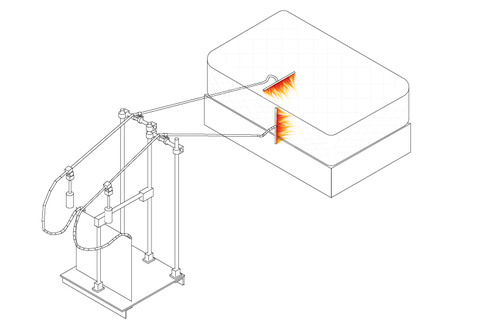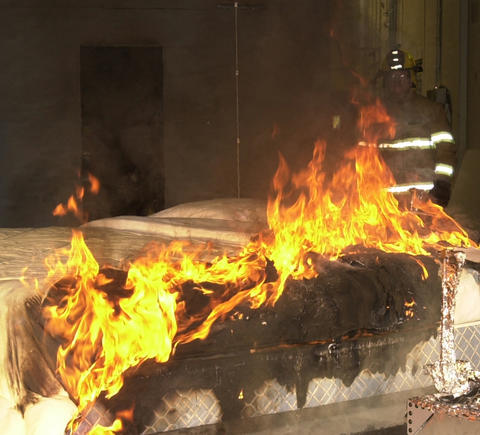Eliminating deaths from flaming bed fires (2000s)
- Bed fires used to cause one in six fire deaths.
- NIST conducted the foundational research needed to pass new laws for safer mattresses.
- Since those laws have passed, bed fire deaths have decreased by two-thirds.
- Studies suggest that when all mattresses are replaced with the safer versions, death from bed fires will become uncommon.
Bed fires used to be incredibly dangerous. Even though they are infrequent, in the early 2000s, bed fires caused one in six fire deaths in the United States.
In 1999, concerned about this danger, the organization of mattress manufacturers and suppliers, the International Sleep Products Association (ISPA), teamed up with NIST and two regulatory authorities, the Consumer Product Safety Commission (CPSC) and the California Bureau of Home Furnishings and Thermal Insulation (BHFTI), to develop a fire safety regulation for mattresses and their foundations. (A mattress foundation is the frame or box spring under the mattress.)
The team quickly realized that they’d need to look beyond just the mattress itself. A mattress is usually wrapped in potentially flammable items that complicate the problem: sheets, blankets and pillows. Together, all these items are called bedclothes.
Bedclothes are a big part of what makes bed fires so dangerous. They act like a steppingstone. A mattress on its own is relatively difficult to ignite. But a sheet or blanket could catch fire from something like a tipped candle. Then, that medium-sized fire gets hot enough to ignite the mattress and surrounding furniture.
It would be impractical to regulate every possible combination of mattress and bedclothes, so NIST staff members started to develop a more pragmatic approach. Instead of using actual sheets and pillows in the test, they would design a machine to simulate severely burning bedclothes.
Before they could make this machine, the researchers needed to make careful measurements of the real thing. NIST burned a variety of bedclothes in a laboratory. This helped them create a “standard severe bedclothes fire,” which was a map of where the most intense flames impacted the mattress and the foundation underneath.

The machine they came up with was a twin burner that accurately and repeatably simulated that standard bedclothes fire.
Now they could make a repeatable flammability test for any mattress. The NIST test method involves exposing a mattress and foundation to the bedclothes fire simulator and making a measurement called the peak heat release rate (PHRR). PHRR is the maximum heat generated as the bed burns and is measured using oxygen consumption calorimetry. It’s the most important number for determining how deadly a burning object is.
Using this test, the researchers were able to study the basics of what makes a bed fire so dangerous. They found that the PHRR from a flaming twin-sized bed was about 2 megawatts (MW), while a king-sized bed could get up to 4 MW.
Either number is absolutely deadly. In a modest-sized bedroom, the radiant heat from a 1 MW fire is intense enough to ignite all the combustible items in the room. This is called flashover. The environment in a flashed-over room is lethal. Then, the fire and smoke can spread to other rooms, increasing the risk of death elsewhere in the building.
Data from the National Fire Incident Reporting System (NFIRS), maintained by the U.S. Fire Administration (USFA) and analyzed by the National Fire Protection Association (NFPA) and NIST, showed that reducing the potential for bedroom flashover should significantly reduce casualties from flaming bed fires.
This set a clear goal for how fire resistant a safer mattress needed to be: A burning mattress and foundation set should not lead to room flashover and should be unlikely to ignite the other furnishings in the room.
NIST staff members measured the heat required to ignite common bedroom furnishings located at different distances from a burning bed. Based on that work, they came up with a number: A PHRR below 400 kW should lead to a significant reduction in lives lost from flaming bed fires.

Now that there was a way to measure bed flammability and a clear lifesaving target number, it was possible to enact laws and regulations for mattress manufacturers to design compliant products. The first law, a California regulation by the BHFTI, went into effect on Jan. 1, 2005. Two years later, that state law was superseded by a federal regulation, 16 CFR Part 1633, issued by the CPSC.
For its regulation, the CPSC chose a limiting PHRR value of 200 kW during a 30-minute test. It also required that the total heat released during the first 10 minutes of a test should not exceed 15 megajoules, giving people more time to escape early in the fire.
The manufacturers designed new mattresses that could meet these regulations, and they even went beyond the legal minimum. The actual PHRR values of compliant mattresses are typically below 100 kW.
In 2021, NIST looked back at data from fires to see whether the CPSC regulation worked.
It did.
By the end of the first decade, NIST estimated that two-thirds of the old mattresses had been replaced by the new, less flammable mattresses. Over that same time period, the decrease in deaths from bed fires was also two-thirds.
This suggests that when all mattresses have been replaced, fatalities from flaming bed fires will be uncommon.
Additional Reading:
NIST report: Flammability Assessment Methodology for Mattresses, 2000.
NIST report: Estimating Reduced Fire Risk Resulting from an Improved Mattress Flammability Standard, 2002.
Federal regulation: 16 Code of Federal Regulations Part 1633, 2006.
Journal article: Estimating the Impact of the Fire Safety Standard 16 CFR Part 1633 on Bed Fire Outcomes. Fire and Materials, 2020.
National Fire Incident Reporting System (NFIRS): About NFIRS.

